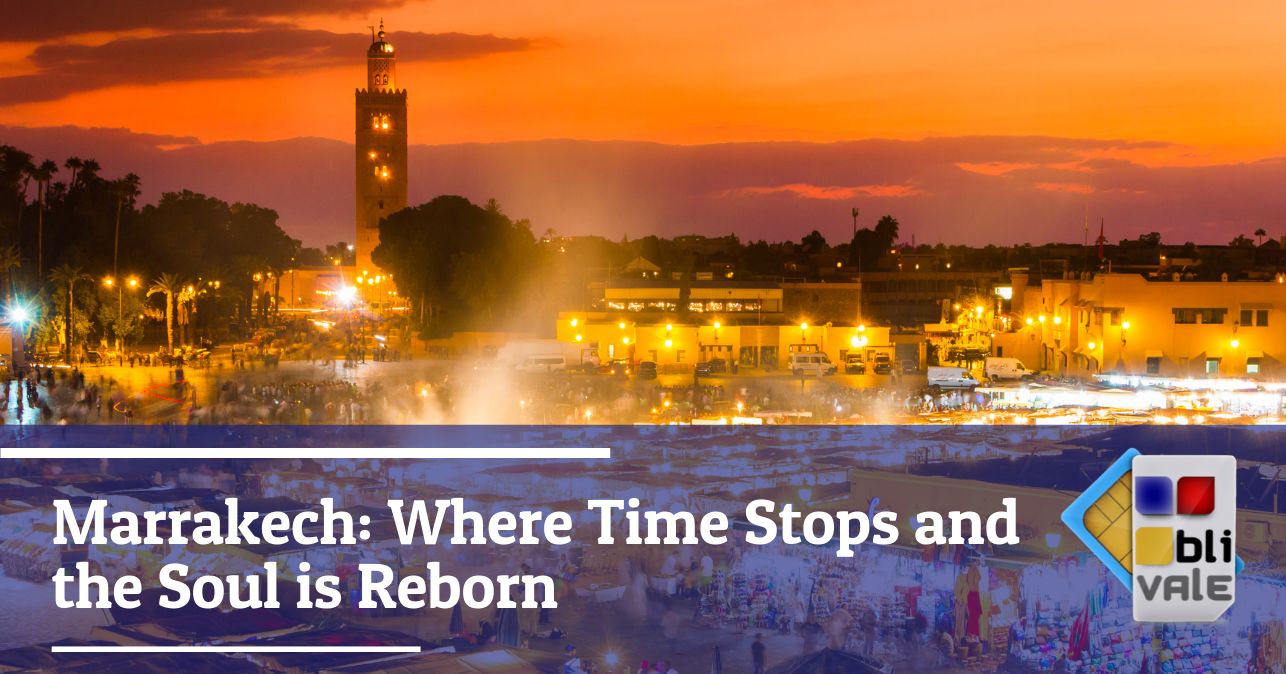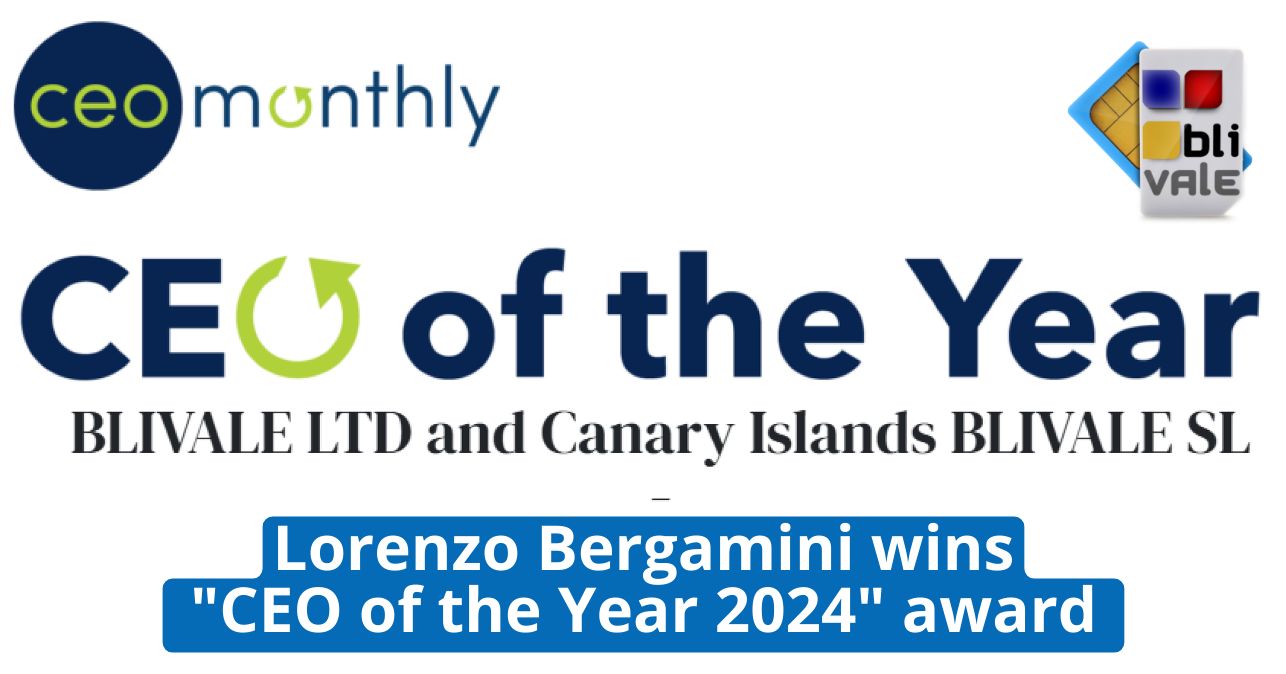The first time you see Marrakech, the world you knew disappears. The scent of saffron, mint and cedarwood fills the air while the warmth of the red earth creeps under your skin. It is not just a city to visit, it is a transformative experience, a sensory journey that remains imprinted on your soul long after you have returned home. Here's how to experience this ancient city intensely in a four-day itinerary, always staying connected thanks to the eSIM BLIVALE Unlimited .
4 Days Itinerary in Marrakech: A Journey Through the Senses
Day 1: The Medina - A Labyrinth of Wonders
Morning:
Waking up in Marrakech is accompanied by the chant of the muezzin echoing in the fresh morning air. Begin your adventure with a traditional Moroccan breakfast: homemade bread, cold-pressed olive oil, argan honey and the signature mint tea served with a theatrical gesture from above, creating a golden foam in hand-decorated glasses.
Head to the legendary Jemaa el-Fna Square, the beating heart of the city since the 12th century. In the morning, the square is relatively quiet, the perfect time to watch vendors setting up their stalls and local elders playing cards in the shade. From here, delve into the surrounding souks, an intricate maze of alleyways where every turn reveals a new treasure.
The Semmarine Souq will greet you with an explosion of color: hand-knotted Berber carpets with geometric patterns passed down through generations, perforated brass lamps that cast intricate patterns on the walls when turned on, soft camel leather slippers dyed in every shade imaginable. Every object tells a story, every craftsman a custodian of ancient techniques. Watch the coppersmiths hammer intricate trays, creating metallic melodies that resonate through the centuries-old walls.
Afternoon:
After a light lunch in one of the small hidden cafes (try the lamb tagine with prunes and almonds or the pastilla, a sweet-savory pigeon pie with cinnamon and powdered sugar), head to the Bahia Palace. This 19th-century masterpiece represents the pinnacle of Moroccan architecture, built for the Grand Vizier Si Moussa and later expanded by his son Bou Ahmed.
Stepping through the carved cedar gates, you enter a world of unexpected tranquility. Courtyards adorned with trickling fountains, gardens of fragrant orange trees, wooden ceilings painted with mesmerizingly intricate geometric patterns, and zellige—tile mosaics—so meticulous that every square inch may contain dozens of tiny pieces cut and placed by hand. Polished marble floors reflect the light that filters through windows screened by intricately perforated wooden grates, designed to allow the women of the harem to observe without being seen.
Continue to the nearby Mellah, the old Jewish quarter, where you can discover a different side of Moroccan history. The houses here are distinguished by their wooden exterior balconies, in contrast to the introverted architecture of Muslim homes. Visit the Slat Al Azama synagogue and the Jewish cemetery, evidence of the centuries-old coexistence of different cultures.
Will be:
At dusk, return to Jemaa el-Fnaa Square to witness its magical transformation. What was an open space during the day suddenly fills with life: dozens of food stalls are set up in an orchestrated symphony of movement, clouds of fragrant steam rise from pots of harira soup, rows of lamb skewers sizzle on braziers, while mountains of boiled snails are seasoned with cumin and salt.
Snake charmers play their hypnotic flutes, Berber storytellers gesticulate animatedly amidst rapt crowds, colorfully dressed Gnawa musicians produce driving rhythms with their qraqeb (metal castanets) and guembri (three-stringed bass). Hennaed women paint intricate ephemeral designs on visitors’ skin, while vendors of fresh orange juice compete vigorously for customers.
Climb to one of the panoramic terraces of the surrounding cafés to observe this spectacle from above while enjoying a mint tea or a traditional dinner. The Café de France or the Café Glacier offer spectacular views. As night falls, the lights of the square transform the scene into a magical theater under the stars.
Day 2: Gardens and Palaces - The Elegance of Marrakech
Morning:
Start your day early by heading to the Majorelle Gardens, an oasis of tranquility just a few kilometers from the bustle of the medina. Created by the French painter Jacques Majorelle over the course of forty years and later saved and restored by Yves Saint Laurent and Pierre Bergé, these gardens are a botanical and artistic masterpiece.
Majorelle Blue – a deep cobalt blue that defines the garden’s identity – stands out against the lush green of over 300 plant species from five continents. Monumental cacti, swaying palms, placid water lilies, rustling bamboos and explosive bougainvillea create an almost dreamlike landscape. Musical fountains and winding paths invite contemplation, while the chromatic contrast between deep blue, sunny yellow and emerald green creates an atmosphere that seems to have come straight from a canvas.
Visit the Berber Museum housed within the garden, which houses an extraordinary collection of jewelry, textiles, weapons and artifacts that tell the rich culture of the indigenous peoples of North Africa. Each display case is a world in itself, theatrically lit to highlight the fine craftsmanship and aesthetic vision of these ancient cultures.
A few steps away, the Yves Saint Laurent Museum is a tribute to the iconic designer who loved Marrakech so much. The building itself is a contemporary masterpiece inspired by Moroccan fabrics, embroidery and culture. Inside, a permanent collection of haute couture dresses traces the designer's extraordinary career, while temporary exhibitions explore his creative process and his relationship with the red city.
Afternoon:
After lunch in one of the elegant cafés in the Gueliz area (the modern quarter built during the French protectorate), such as the Grand Café de la Poste with its ceiling fans and colonial atmosphere, head to El Badi Palace.
“El Badi” means “the incomparable,” and when it was completed in 1593 to celebrate Sultan Ahmad al-Mansur’s victory over Portuguese power, it was truly peerless. Today, though stripped of its treasures (Italian marble, Timbuktu gold, crystal), its imposing ruins retain a majestic aura. Vast courtyards, now-empty reflecting pools, and massive walls testify to the grandeur of the Saadian Empire. Storks nesting on the ancient walls add a picturesque touch, their silhouettes silhouetted against the blue Moroccan sky.
The panoramic view from the terrace offers an unforgettable spectacle over the rooftops of Marrakech, with the snow-capped Atlas on the horizon. From the palace, a short walk will take you to the Museum of Photography of Marrakech, which houses an extraordinary collection of historical images of Morocco from 1870 to 1960. These black and white photographs offer a fascinating glimpse into a Morocco that no longer exists: portraits of proud Berbers, scenes of daily life in the souks, court ceremonies and pristine landscapes.
Continue to the Saadian Tombs, a funerary complex that remained sealed for centuries and was only rediscovered in 1917. Entering through a narrow passage, you suddenly find yourself in a serene garden with intricately carved Carrara marble tombs. The Hall of Twelve Columns, where Sultan Ahmad al-Mansur rests, is a masterpiece of Islamic art: vaulted ceilings of carved cedar wood inlaid with gold, delicate lace-like stucco, and Italian marble columns supporting perfect arches. Light filters through strategic openings, creating ethereal plays of light in this sacred space.
Will be:
For dinner, book in advance at one of the traditional riads turned luxury restaurants. A riad is a traditional Moroccan house built around a central courtyard, often with a fountain and citrus trees, offering coolness and privacy. Riad Kniza or Dar Moha are excellent choices where Moroccan haute cuisine meets a Arabian Nights atmosphere.
Dinner will be accompanied by live traditional music and perhaps a belly dance. Savor a series of refined dishes: crispy pastilla, fragrant tagine, airy couscous, and almond and honey desserts. Each bite contains centuries of culinary tradition, influenced by the Arabs, Berbers, Andalusians and French.
If you are thinking of taking a trip alone or with friends or for work, do not forget the importance of staying connected wherever you are. For unlimited Internet connection, contact BLIVALE where you can get unlimited Internet according to the destinations:
For unlimited plans like data BLIVALE guarantees free roaming anywhere in the world, no additional or hidden costs. Don't let the lack of connection stop you; get ready to explore the world with freedom and spontaneity.
Day 3: Relax and Culture - The Rituals of Marrakech
Morning:
Spend the morning enjoying one of Morocco’s oldest and most rejuvenating rituals: the hammam. This traditional steam bath has been an integral part of Moroccan social life and hygiene for centuries. For an authentic yet comfortable experience, choose Hammam de la Rose or Les Bains de Marrakech.
The experience begins in a warm room where your body gradually acclimates to the heat. You will then move to a warmer room where steam opens your pores. An attendant (called a tellak) will scrub you vigorously with a kessa glove and black soap made from olives, removing layers of dead skin in a cleansing ritual that dates back hundreds of years. A refreshing shower, followed by a massage with argan oil, will complete the treatment, leaving you in a state of deep relaxation.
Afternoon:
Feeling refreshed, head to the Medersa Ben Youssef, the largest Koranic school in North Africa and a masterpiece of 14th-century Moroccan architecture. The central courtyard is a triumph of symmetry and beauty: a white marble floor, a fountain for ablution, and walls covered in zellige (geometric mosaics), gebs (stucco), and carved Arabic calligraphy reproducing verses from the Koran. The 130 small cells on two floors surrounding the courtyard housed up to 900 students, who lived in spartan conditions while studying Islamic theology.
Light filtering through the wrought iron windows creates changing patterns on the floor, while the perfect acoustics of the courtyard allowed all students to hear the teacher at the center. The carved and painted cedar ceilings feature astronomical and geometric patterns of incredible complexity, a testament to Moroccan craftsmanship.
After lunch at a traditional restaurant such as Naima (for an authentic local experience) or Nomad (for a contemporary take on Moroccan cuisine with a rooftop terrace), continue to the Koutoubia Mosque, Marrakech’s most iconic monument.
Although the interior is accessible only to Muslims, the exterior is equally impressive. The 77-meter-high minaret, completed in the 12th century under the Almohad dynasty, is a masterpiece of harmonious proportions and sober decoration that has influenced religious architecture throughout the Western Islamic world, including the Giralda in Seville. The four copper spheres at its summit, according to legend, were originally made of gold, donated by the caliph's wife in atonement for breaking the fast of Ramadan.
End the afternoon with a stroll through the Menara Gardens, a vast 12th-century olive grove centered around a large artificial pond and an elegant pavilion with a green pyramidal roof. This pond, fed by an ancient hydraulic system that brought water from the Atlas, served both for irrigation and as a place for the rulers to relax. At sunset, the view of the pavilion reflected in the water with the mountains in the background is simply magical.
Will be:
For dinner, choose one of the panoramic restaurants overlooking the illuminated medina. The Nomad, La Terrasse des Épices or the Café des Épices offer terraces from which you can watch the sun set over the rooftops of the old city, with the illuminated Koutoubia and the Atlas Mountains in the distance. As the sky changes from light blue to orange to pink to deep blue dotted with stars, you can reflect on the wonders you have discovered so far.
Day 4: Between Mountains and Crafts - The Soul of Morocco
Morning:
Wake up at dawn for a hike in the Atlas Mountains, just an hour's drive from Marrakech. The contrast between the arid heat of the city and the clean, fresh air of the mountains is striking. As you ascend, the landscape changes dramatically: green agricultural terraces, dirt Berber villages that seem to grow organically from the mountain itself, and finally rocky slopes that lead to snow-capped peaks.
Imlil, at around 1,740 metres above sea level, is the starting point for many hikes to Mount Toubkal, the highest peak in North Africa (4,167 m). Even without undertaking the full climb, a few hours’ walk will allow you to soak up spectacular views and meet the Berbers, the native people of the mountains, known for their legendary hospitality and resilience in this harsh environment.
Villagers still wear traditional clothing: djellabas (long hooded robes) for men and colorful dresses with silver jewelry for women. Mules remain the primary means of transportation on these steep trails, just as they were centuries ago.
For lunch, enjoy a meal in an authentic Berber home. You will be greeted with traditional mint tea (jokingly called "Berber whiskey") ceremoniously prepared in front of you: the tea is poured from a considerable height into glasses to create the characteristic foam, and served three times following the saying "the first is bitter like life, the second strong like love, the third sweet like death". A typical lunch consists of a chicken tagine with preserved lemon and olives, or lamb with prunes and almonds, accompanied by round bread baked in the village's communal oven.
Afternoon:
Returning to Marrakech in the early afternoon, make some last-minute purchases in the artisanal quarter of Ensemble Artisanal. Unlike the souqs, here prices are fixed (avoiding the need to bargain) and quality is guaranteed. You will find the best of Moroccan craftsmanship: carpets, ceramics, jewelry, leather goods, carved wood objects and much more.
This is the perfect time to buy those special pieces you have been admiring in the previous days: a Berber carpet with ancient geometric patterns that tell tribal stories, a hand-engraved brass tea set, a perforated iron lamp that will cast magical patterns on the walls of your home, or perhaps some natural cosmetics such as argan oil, the "liquid gold" of Morocco, produced exclusively in this region.
Each object carries with it not only centuries-old craftsmanship, but also a piece of the soul of Marrakech that will continue to live in your home.
Will be:
For your last evening, treat yourself to a luxurious dinner in one of the city's most beautiful traditional palaces. La Maison Arabe, one of the first luxury riads in Marrakech, offers an extraordinary gastronomic experience in a dreamy setting. Otherwise, Dar Yacout, with its intricate stucco, colorful zelliges, and romantic courtyards lit by hundreds of candles, is the pinnacle of Moroccan hospitality.
The tasting menu will take you on a journey through Morocco’s finest flavors: briouates (crispy stuffed rolls), colorful salads, innovative tagines, regal couscous, and Moorish pastries washed down with surprisingly good Moroccan wines from the Meknes or Ourika Valley regions.
As you enjoy this last dinner under the stars of the Moroccan sky, surrounded by the timeless beauty of an ancient palace, reflect on all the treasures you have discovered, the experiences you have lived, the flavors you have savored and the people you have met. Marrakech is not just a destination, it is a journey into the soul – a place that changes you forever.
Stay Connected in Marrakech
Throughout your stay, the BLIVALE Unlimited eSIM will allow you to stay connected without worries, sharing every magical moment with friends and family. From navigating the labyrinthine souqs to hiking in the Atlas Mountains, your connection will follow you everywhere, allowing you to:
Instantly share photos and videos on social media
Use detailed maps to orient yourself in the medina, where the streets have no names
Translate conversations with locals in real time
Research historical information about monuments as you visit them
Book restaurants, hammams and guides with ease
Stay in touch with home without worrying about exorbitant roaming charges
Practical Tips for an Unforgettable Trip
Local guide: Hire an official guide (recognizable by the badge) for the first day in the medina. Not only will you avoid getting lost, but you will discover hidden corners and stories that would otherwise escape you.
The Art of Bargaining: In the souqs, bargaining is part of the experience. Start by offering about a third of the asking price and proceed calmly and with smiles. The final price should be about half of the initial price. Don't show too much enthusiasm for an item and be willing to walk away.
Respectful Dress: Although Marrakech is accustomed to tourists, Morocco is still a conservative Muslim country. Women should cover their shoulders and knees, and men should avoid shorts, especially when visiting religious sites or traditional neighborhoods.
Food Safety: Drink only sealed bottled water and be careful with raw or undercooked foods. Salads and freshly peeled fruit are generally safe in good restaurants.
Sun Protection: Even in winter, the Moroccan sun can be intense. Always carry a hat, sunglasses, sunscreen and a bottle of water.
Connectivity: Activate your BLIVALE eSIM before departure to have it already working upon arrival. Also download some offline maps as a backup, especially for mountain excursions.
Photographic Respect: Always ask permission before photographing people. Some artisans or vendors may ask for a small fee, which is reasonable to pay.
Craft Demonstrations: Be wary of unofficial guides who insist on taking you to craft or dyeing “demonstrations” – these are often a ploy to get you into shops where you will be pressured into buying.
Marrakech is a city that slowly reveals itself, layer by layer, like its thousand-year-old stories. With each visit, you will discover new secrets, new flavors, new colors. The red city is not just a place to visit, but an experience to live with all your senses open, a journey into the soul that will continue to resonate within you long after you have returned home









